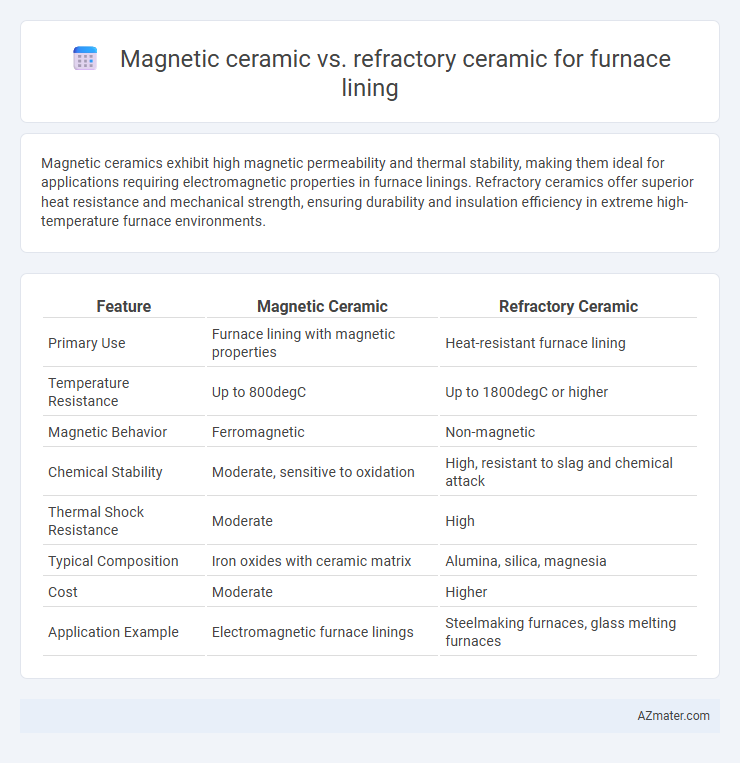Magnetic ceramics exhibit high magnetic permeability and thermal stability, making them ideal for applications requiring electromagnetic properties in furnace linings. Refractory ceramics offer superior heat resistance and mechanical strength, ensuring durability and insulation efficiency in extreme high-temperature furnace environments.
Table of Comparison
| Feature | Magnetic Ceramic | Refractory Ceramic |
|---|---|---|
| Primary Use | Furnace lining with magnetic properties | Heat-resistant furnace lining |
| Temperature Resistance | Up to 800degC | Up to 1800degC or higher |
| Magnetic Behavior | Ferromagnetic | Non-magnetic |
| Chemical Stability | Moderate, sensitive to oxidation | High, resistant to slag and chemical attack |
| Thermal Shock Resistance | Moderate | High |
| Typical Composition | Iron oxides with ceramic matrix | Alumina, silica, magnesia |
| Cost | Moderate | Higher |
| Application Example | Electromagnetic furnace linings | Steelmaking furnaces, glass melting furnaces |
Introduction to Furnace Lining Materials
Magnetic ceramic and refractory ceramic are critical materials for furnace lining, designed to withstand extreme temperatures and provide thermal insulation. Magnetic ceramics offer superior magnetic properties and enhanced thermal stability, making them suitable for specialized applications requiring magnetic responsiveness and heat resistance. Refractory ceramics prioritize high melting points, chemical inertness, and mechanical strength, ensuring durability and protection of furnace structures under prolonged exposure to molten materials and thermal cycling.
Overview of Magnetic Ceramics
Magnetic ceramics, typically composed of ferrites such as spinel or garnet structures, exhibit high magnetic permeability and electrical resistivity, making them suitable for specialized furnace linings where electromagnetic properties are critical. Unlike refractory ceramics designed primarily for high thermal resistance and mechanical strength at elevated temperatures, magnetic ceramics integrate magnetic functionality, which can influence heat distribution and electromagnetic shielding inside the furnace. Their use in furnace lining is optimized for applications requiring the combination of thermal stability with magnetic field control, distinguishing them from traditional refractory materials.
Overview of Refractory Ceramics
Refractory ceramics are engineered for high-temperature resistance, thermal stability, and chemical inertness, making them essential for furnace linings subjected to extreme heat and corrosive environments. Unlike magnetic ceramics, refractory ceramics such as alumina, silica, and magnesia provide superior insulation and structural integrity under continuous thermal cycling. Their tailored composition enhances durability and energy efficiency in industrial furnaces, optimizing performance and lifespan.
Key Properties of Magnetic Ceramics
Magnetic ceramics for furnace lining exhibit high magnetic permeability, excellent thermal stability, and resistance to oxidation at elevated temperatures, making them ideal for applications requiring electromagnetic interference shielding and heat insulation. Their superior mechanical strength and thermal shock resistance ensure durability under cyclic heating and cooling conditions, unlike refractory ceramics, which mainly emphasize high melting points and chemical inertness. Magnetic ceramics also offer enhanced electrical insulation properties alongside their magnetic functionality, providing multifunctional benefits in advanced furnace environments.
Key Properties of Refractory Ceramics
Refractory ceramics for furnace lining exhibit exceptional thermal stability, resistance to high temperatures exceeding 1700degC, and strong chemical inertness against molten metals and slags, making them ideal for harsh industrial environments. Magnetic ceramics, while featuring unique electromagnetic properties, generally lack the superior thermal shock resistance and corrosion resistance essential for furnace lining applications. Key properties of refractory ceramics include high melting points, low thermal conductivity, excellent mechanical strength, and minimal thermal expansion, ensuring durability and longevity in extreme furnace conditions.
Performance Comparison: Thermal Resistance
Magnetic ceramics offer enhanced thermal resistance compared to refractory ceramics, withstanding temperatures exceeding 1600degC while maintaining structural integrity in furnace lining applications. Refractory ceramics generally operate effectively up to 1400degC but may experience reduced performance under thermal cycling conditions. The superior thermal conductivity and stability of magnetic ceramics optimize furnace efficiency and lifespan, making them ideal for high-temperature, high-stress environments.
Durability and Longevity Analysis
Magnetic ceramics, primarily composed of iron oxide with high thermal conductivity, exhibit superior resistance to thermal shock and mechanical wear compared to refractory ceramics, enhancing furnace lining durability. Refractory ceramics, such as alumina and silica-based materials, offer exceptional chemical stability and high melting points but may suffer from brittleness under cyclic thermal stress, impacting longevity. Durability analysis indicates magnetic ceramics maintain structural integrity longer in high-temperature environments, reducing maintenance frequency and improving overall furnace life span.
Cost Implications and Material Availability
Magnetic ceramics for furnace lining generally offer lower upfront costs due to abundant raw materials like iron oxides but may require more frequent replacement, increasing long-term expenses. Refractory ceramics, such as alumina and zirconia-based materials, have higher initial costs driven by complex processing and limited raw material sources but provide superior thermal stability and durability, reducing maintenance and downtime costs. Material availability for magnetic ceramics is typically more widespread in industrial regions, while refractory ceramics often depend on specialized suppliers, impacting procurement time and overall project budgeting.
Applications and Suitability for Different Furnaces
Magnetic ceramic linings exhibit superior resistance to corrosion and thermal shock, making them ideal for electric arc furnaces and induction furnaces that operate under highly magnetic fields and fluctuating temperatures. Refractory ceramics provide excellent chemical stability and high melting points, which suit blast furnaces and coke ovens used in steelmaking and metallurgical processes. The choice between magnetic and refractory ceramics depends on furnace type, operational temperature, exposure to slag, and magnetic field presence, optimizing durability and performance in specific industrial applications.
Choosing the Best Ceramic for Furnace Lining
Magnetic ceramics, such as magnesite and spinel, offer excellent thermal conductivity and resistance to chemical attack, making them ideal for high-temperature furnace linings where heat distribution is critical. Refractory ceramics, including alumina and silica-based materials, provide superior thermal insulation and mechanical strength, which are essential for protecting furnace structures from extreme heat and corrosion. Selecting the best ceramic for furnace lining depends on factors like operating temperature, chemical environment, thermal shock resistance, and the specific furnace application.

Infographic: Magnetic ceramic vs Refractory ceramic for Furnace lining
 azmater.com
azmater.com